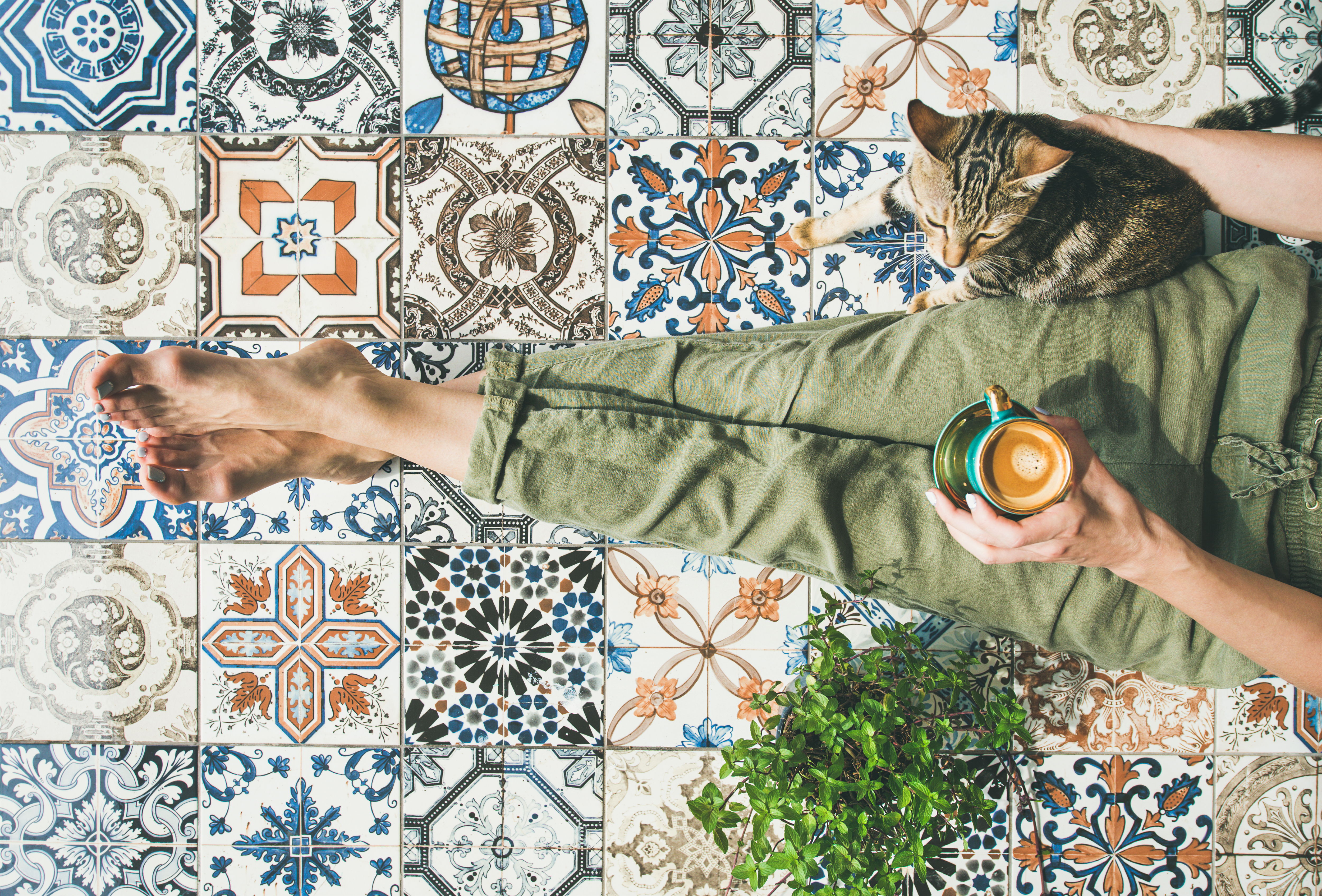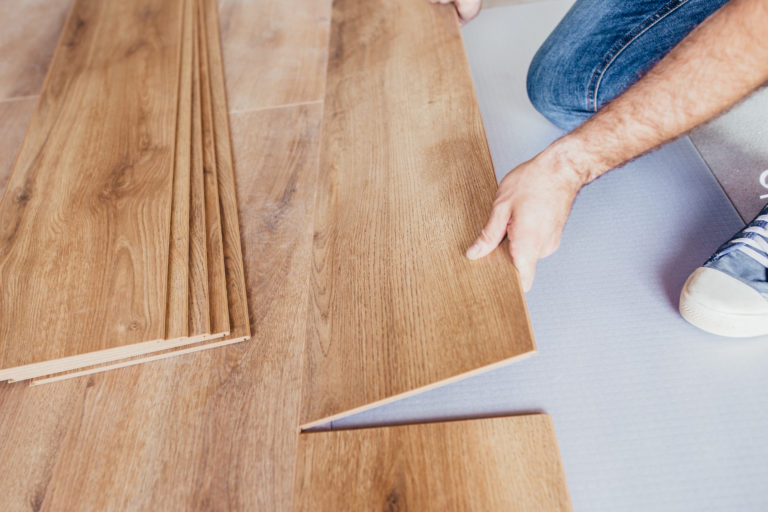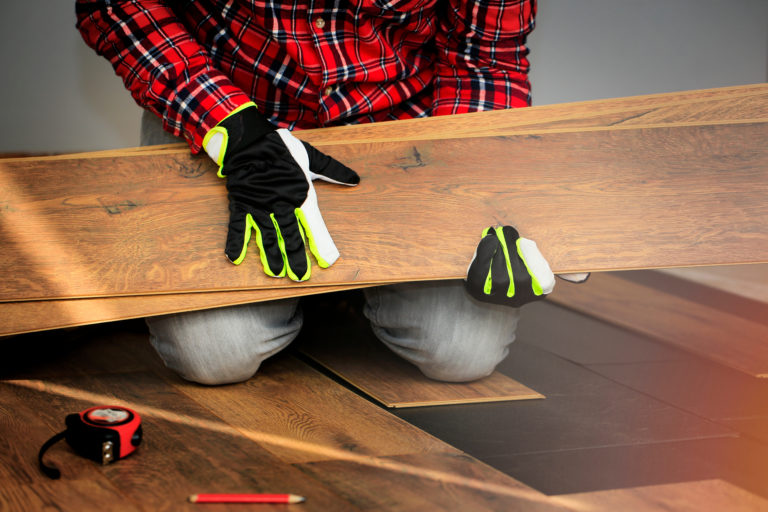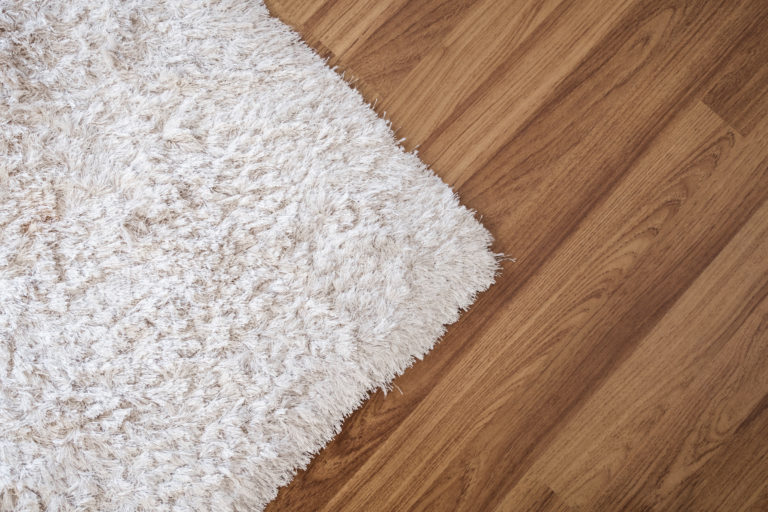This post may contain references or links to products from one or more partners of our parent company and/or subsidiaries of our parent company. For more information, visit this page.
Updated August 2, 2023
If you’re looking into different types of floor tiles, you’re probably in on the secret already.
But if not, you should know: tile is cool now! And we mean cool. Like, hipster-fabulous, Brooklyn-bound, ultra-chic cool. Let’s put it this way: tile is so cool, the Washington Post even wrote an article about just how cool it is.
So if you’re looking into different types of floor tiles for your home…well, we really can’t blame you.
We know there are so many different tile brands, so we did the research, testing and customer interviews for you.
- The best ceramic or porcelain tile brand is Paradiso.
- The best luxury vinyl tile brand is Proximity Mills, Doma or Trucor.
- The best alternate option to tile is laminate, and our favorite brand is Newton.
But really, tile is so much more than a trend. It’s one of the oldest flooring surfaces in the world and it’s one of the most versatile. It can go everywhere and anywhere, from bathrooms to kitchens to bedrooms and beyond. And it’s incredibly varied; there are so many kinds of tile it’ll make your head spin.
That’s why today, we’re going to take you on a journey through the beautiful, historical, and wide-ranging world of tile options. We’re going to talk ceramic vs. porcelain; we’re going to talk glazed vs. unglazed; we’re going to talk cement, stone, and wood-look tile. We’re even going to talk about tile installation and maintenance.
We’re going to teach you everything you need to know to choose the right types of floor tiles for you. Because when we’re talking about types of flooring, there’s no such thing as too much information.
Types of Floor Tiles: Quick Summary
When it comes to floor tiles, you’ve basically got two overall options: man-made and stone.
Types of man-made floor tiles include ceramic, porcelain, and cement. Stone tiles are made of actual stone (duh), like marble, granite, and limestone. Occasionally there are resin tiles designed to emulate natural stone.
When we measure how slip-resistant a tile is, we use a scale called the Coefficient of Friction Rating (COF). The higher the rating, the more grip the tile has. And for reference, a COF of .50 or higher is recommended for flooring.
Still with us? Good.
Best Brands of 2024
Ceramic Tile vs. Porcelain Tile: Which is The Better Type of Floor Tile?
Ceramic and porcelain tiles are some of the oldest and most popular flooring options in the world. And it’s not hard to see why—they’re gorgeous, versatile, and durable. Some ancient ceramic tile mosaics have survived literally thousands of years.
That said, we know you’re more interested in choosing a tile for your home than you are in choosing a tile that’s going to survive until the year 3000. So let’s talk specifics.
What’s the difference between ceramic and porcelain tile?
Technically speaking, porcelain is a type of ceramic. Both are made by baking clay at a super-high temperature in a kiln until a durable and waterproof flooring option is created.
However: porcelain tile is made of a more refined clay than ordinary ceramic is, and it’s baked at a higher temperature as well. That makes it less porous (certified porcelain tile is required to have a water absorption rate of 0.5% or lower), less prone to staining, and often, a more durable flooring material.
But porcelain has downsides too—it’s heavier, more expensive, and can be more slippery than ordinary ceramic (which usually has a higher COF rating).
Glazed vs. Unglazed Floor Tiles
The process of glazing tile involves baking an extra layer of enamel or liquid glass over it tile at a super-high temperature. When it cools, glaze provides a tile’s “finish”.
Is glazed tile better than unglazed tile?
Like all things flooring, the question of “which is better” depends on your taste and needs. Both ceramic and porcelain tiles come in glazed and unglazed versions, and each one boasts a distinctive look and feel.
What are the pros and cons of glazed tile?
But when you think of those hipster-fabulous tile patterns we talked about earlier, you’re probably picturing glazed tile. These are covered in a thin sheet of glaze (obviously), which is usually colored and/or patterned.
The glazing process gives tiles more resistance to stains and moisture, but it also lowers their COF (an issue if you’re thinking of using them in a bathroom, for instance). And because the glaze is only on the surface of the tile, any breaks or chips in it are going to stand out.
What are the pros and cons of unglazed tile or a “Quarry Tile”?
Unglazed tiles can be a bit rougher, which means they’re more slip-resistant. Unglazed ceramic tile—or “quarry tile” as it’s sometimes called—usually boasts a COF of .70 and over. It’s a super-popular kitchen and bathroom floor for that exact reason.
Unglazed tile is also the same color all the way through, so any cracks or chips that develop over time aren’t as obvious. And as far as style is concerned, a lot of people love the rustic look of unglazed tile.
But of course, it is rougher and unglazed ceramic is very porous—so you need to be careful when you’re choosing where to put it.
Cement Floor Tiles
These days, tiles can be made out of just about anything. And manufacturers are really leaning into that. There are tons of types of floor tiles out there—glass, cement, resin, even metal (and that’s not even going into the endless types of vinyl flooring that have become super popular lately).
But sadly, not all these types of tile can be used as floor tiles. Glass tile, for instance, is too breakable—and metal’s COF is way too low. That said, one “alternative” tile that’s become incredibly trendy in recent years is cement tile.
Unlike ceramic, cement tile isn’t fired in a kiln. Instead, it’s cured at room temperature. It’s a really popular type of flooring tile (especially in Europe) for a number of reasons:
- It comes in some beautiful patterns and colors.
- It’s extremely durable.
- It can be refinished.
- It’s environmentally friendly.
- Cement tiles are great for a number of situations like pool decks, kitchen, bathrooms and elsewhere.
But again, there are downsides. Cement tile is cold underfoot, it’s extremely porous, and it needs to be resealed every two to three years (one of the reasons concrete flooring that looks like wood isn’t too high up on the list of fake wood flooring options.
Plus, the tiles themselves are quite thick and really heavy, so they need to be supported by a strong subfloor—or, as they say, “you’re gonna have a bad time”.
Stone Floor Tile
Stone tile (sometimes called “natural” stone tile) is always a favorite. If you want a high-end look that will last a lifetime, stone is a great choice. Come on, who doesn’t love a marble floor?
And because stone tile is mined rather than manufactured, no two pieces are the same—meaning there’s a huge amount of beautiful, natural variation in each individual tile. And because it’s not manufactured, you’re getting one of the most natural, eco-friendly flooring options possible.
Stone tile can go just about anywhere, but keep in mind that certain types have higher COF ratings than others.
Types of natural stone tile
Along with marble, some of the most popular stone tiles include:
Sandstone – With its dreamy patterns and gorgeous waves, it’s easy to see why sandstone has been a popular type of floor tile for ages.
Limestone – Whether you’re looking for a variation like travertine or something more traditional, limestone always makes for a great floor.
Travertine – A type of limestone that often has a creamy, fibrous look.
Quartzite – A type of hard, glassy sandstone that sparkles with tiny quartz crystals.
Slate – A tough, beautiful stone with an excellent COF rating—making it very popular for kitchens.
Granite – Everyone’s favorite countertop, granite comes in endless variations and types (no wonder people love it).
Onyx – A stunning semi-precious stone, onyx is actually a type of quartz that boasts amazing patterns, swirls, and variations.
Marble Tile – Marble tiles are known for how good they are. They are high-quality and long-lasting pieces of nature that bring stunning and unique beauty to any space.
Keep in mind that these are only a few of the natural stone materials available when you’re looking for different types of floor tiles. And don’t forget that each material comes in endless variations of colors and patterns. Essentially, your options are never-ending.
Wood-Look Floor Tile
If you’re looking into hardwood floor alternatives, you’ve probably seen the phrase “wood look tile” at least a couple of times. And there’s a reason for that—it’s getting super popular. Here’s what you need to know about it.
What is wood look tile?
What is wood look tile? It’s tile…that looks like wood. Underwhelmed? Don’t be. Wood look tile is actually super cool. See, all wood flooring types have their upsides and their downsides. And with hardwood floors, most of those downsides have to do with water and humidity issues. Example: you shouldn’t really put wood in a bathroom. Even the best engineered wood flooring will swell, warp, and ruin your day. It’s one of the disadvantages of engineered wood and solid wood.
Wood look tile, on the other hand, can go absolutely anywhere (because tile can go absolutely anywhere). And manufacturing patterns have become so advanced that unless you’re physically touching the floor, it’s almost impossible to tell the difference between wood look tile and actual wood. Some tiles even come in strips like actual wood planks. Cool, huh?
Mosaic Tiles
Mosaic tiles are an entirely different category altogether. These tiles are those that combine tiles of different sizes, shapes, textures, colors, materials and more into sheets. These sheets are connected with mesh backing, making them look cohesive, yet random when you place them together. They are relatively simple to install compared to mosaics that are installed one piece at a time.
They are commonly used as a backspace tile, on bathroom floors, on shower floors and in other similar situations.
Metal Tiles
Metal tiles are those that are made from materials like stainless steel, tin or copper. They are often used in kitchens as wall tile or ceiling tile for a sleek, modern look.
Installing Different Types of Floor Tiles
There’s one big aspect of tile that we haven’t talked about yet: grouting.
While tile can be used in just about any room in the home—bedrooms, bathrooms, kitchens, hallways, you name it—the quality of its installation is going to largely depend on the quality of its grouting. Here’s our gem of wisdom: have a professional install and grout your tiles.
Seriously, your tile’s grouting and subfloor can be just as important to its style and longevity as the material itself, so this really isn’t the time to go DIY (unless you really know what you’re doing). So if you just had to look up “what is subflooring?” on Google, find a flooring retailer in your area to do the job right.
Fun fact: these days, some manufacturers like Daltile offer snap-together tile flooring for the more advanced DIYers among us!
Maintaining Floor Tiles
Durability is one of tile’s chief advantages. Foot traffic, pets, even heavy furniture won’t phase it. But: it’s important to remember that every type of floor tile is different—so in order to ensure your flooring lasts a lifetime, make sure you understand exactly how to maintain it.
Porcelain and ceramic tiles, for instance, don’t need much TLC beyond periodic regrouting every 12–15 years. Natural stone, on the other hand, may need to be resealed every couple of years depending on the product. And you should never clean it with standard soaps or cleansers—they can cause discoloration.
Basically, our advice is this: do your research. Ask your local flooring retailer about the best ways to maintain the specific types of floor tiles you decide to purchase.
Types of Floor Tiles: The Conclusion
If you’ve taken one thing from this article, we hope it’s this: tile is amazing. It’s beautiful, it’s durable, and it’s endlessly versatile. You can create just about any look with it, from the cosmic twists of onyx to the rich grains of wood look tile.
And with just a little bit of care, your gorgeous tile floor can last a lifetime. So whether you’re putting it in your laundry room, your bedroom, over your underfloor heater, or in a hallway, tile is always a good decision.
Ready to find the perfect tile for you? We can’t blame you. Use this flooring store in my area tool to find a local retailer who can help you through every step of the process. And for more info on all things flooring, don’t forget to check out:
- Types of Flooring Made Simple: The Complete 2022 Guide
- A Guide to Peel-and-Stick Carpet Tiles (& 9 Reasons They’re Amazing)
- Click-Together Flooring: Your Questions Answered
- Carpet vs. Laminate: Which is the Right Floor for You?
- Your Complete Guide to Bamboo Flooring
- Vinyl Flooring Pros and Cons: What You Need to Know
About The Author

John Lahr
September 8, 2022
Associate Director of Content Marketing at FlooringStores (and its parent company, Broadlume), John is a former travel writer, English teacher, and semi-professional trivia host. When he’s not creating content, he can be found doing crosswords, drinking coffee, and petting the office dogs.





